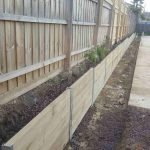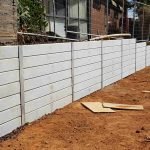Introduction
Building a keeping wall is more than just stacking stones or putting wood; it's an art that http://devinnuou395.wpsuo.com/the-function-of-a-retaining-wall-builder-in-your-garden-job blends engineering concepts, design aesthetics, and practical performance. As we look into From Concept to Conclusion: A Day in the Life of a Retaining Wall Builder, you'll find the intricacies involved in this interesting profession. Whether it's dealing with concrete sleepers, H beams, or lumber sleepers, every element plays a pivotal role in guaranteeing that the structure not only looks excellent however likewise stands the test of time.
What is a Maintaining Wall?
A retaining wall is a structure developed to keep back soil and avoid disintegration on sloped surface areas. These walls are vital for preserving landscape integrity and can be made from numerous materials such as stone, wood, and concrete.
The Function of a Retaining Wall Installer
A retaining wall installer is responsible for transforming strategies into concrete structures. They work carefully with architects and landscape designers to guarantee that the ended up product meets both functional and visual criteria.

Understanding the Different Kinds of Keeping Walls
Concrete Sleepers
Concrete sleepers are pre-cast blocks used for their toughness and sturdiness. They provide exceptional support for heavy loads and are resistant to rot and insect damage.
H Beams
H beams offer significant structural assistance due to their shape, making them perfect for taller keeping walls where additional strength is required.
Wood Sleepers
Though visually appealing, wood sleepers need routine maintenance due to their vulnerability to decay. Nevertheless, they can offer a warm aesthetic that mixes well with natural landscapes.
Timber Sleepers
Timber sleepers are typically utilized in domestic tasks where less height is needed. They can produce a rustic charm but featured concerns about longevity.
Stone Keeping Walls
Stone walls are classic and can include tremendous value to homes. Their natural appearance makes them popular in landscaping designs but requires competent craftsmanship for appropriate installation.
The Preliminary Consultation: What Occurs First?
During the initial assessment stage, a retaining wall contractor consults with customers to discuss their requirements and choices. This stage involves site assessments, comprehending drain concerns, and identifying product choices.
Planning & Style Phase: Crafting the Blueprint
Once preliminary discussions conclude, detailed plans are developed. This plan includes measurements, material specs (be it concrete sleeper or stone), and drain solutions.
Permits & Laws: Browsing Legalities
Before building and construction begins, securing needed authorizations is important. Building regulations vary by place; thus comprehending local policies ensures compliance throughout the project.
Preparing the Website: Clearing & Excavation Work
Preparing the website includes clearing greenery and particles followed by excavation work. This action lays the structure for a structurally sound retaining wall.
Material Selection: Choosing The Right Components
Selecting products lines up closely with style goals while also considering spending plan restraints. Elements like sturdiness (concrete vs. timber sleeper) play a necessary role in this decision-making process.
Foundation Work: The Importance of Stability
A solid structure is non-negotiable when building any keeping wall. Whether using H beams or stone, ensuring stability avoids future collapses or shifts.
Construction Process: Detailed Execution
Lay Out The Plan
Using stakes and string lines assists visualize where each part will go.
Excavate For The Base

Install Drain Solutions
Proper drainage systems prevent soil saturation behind walls.
Constructing The Wall
Depending on selected products (like concrete sleepers), walls might be constructed layer by layer.
Backfilling
When installed, backfilling helps stabilize the structure while guaranteeing appropriate drainage.
Finish Work
Including any wanted functions like caps or decorative elements finishes the look.
Tools of The Trade: Vital Devices For Builders
Having a range of tools at hand makes all jobs much easier:
- Shovels & & Picks Levels Compactors Trowels Power Tools
Quality Control Procedures During Construction
Quality control ensures that every element fulfills market requirements:
- Regular Inspections Material Testing Adherence To Plans
Addressing Challenges On-Site: Problem-Solving Abilities Required
No building and construction job goes off without a drawback! From unforeseen weather changes to material scarcities-- being adaptable is key!
Final Touches: Aesthetic Enhancements For Your Retaining Wall
After building and construction comes beautification:
Landscaping around it Adding plants or lighting Painting or staining wood structuresMaintenance Tips For Durability Of Retaining Walls
To extend the life of your maintaining wall:
- Regularly check for cracks Clean particles Check drainage systems
Common FAQs About Maintaining Walls
1. What materials are best for developing keeping walls?
Choosing between concrete sleeper, stone, timber sleeper depends upon visual preference and structural requirements.
2. How tall can my retaining wall be?
Local regulations determine height limitations; typically in between 4-- 6 feet without unique permits.
3. Do I need planning permission?
In most cases yes; check regional building codes before starting construction.
4. Can I install a maintaining wall myself?
While do it yourself is possible, working with specialists makes sure security and compliance with regulations.
5. How do I keep my keeping wall?
Regular inspections ought to concentrate on looking for fractures or drainage concerns; immediate repair work improve longevity!

6. Are keeping walls expensive?
Costs vary based upon products chosen(e.g., wood vs stone)together with labor expenses involved.
Conclusion
In conclusion, building a retaining wall involves meticulous preparation from start to finish-- hence why understanding every action in this journey from idea through completion matters immensely! From picking products like concrete sleepers or lumber to navigating legal requirements-- it's clear how comprehensive this procedure truly is! So next time you see one standing high against nature's forces-- take a minute to appreciate all that went into developing it!